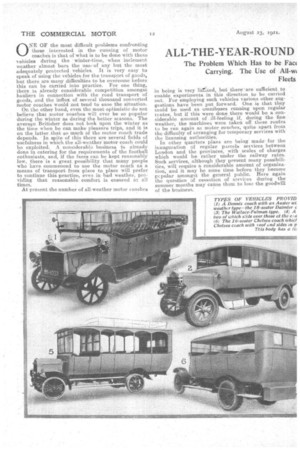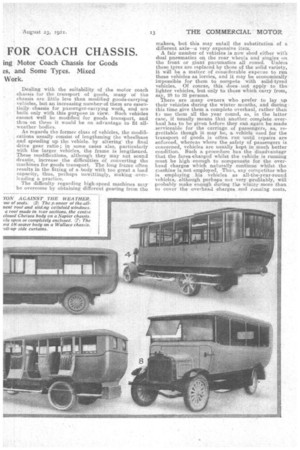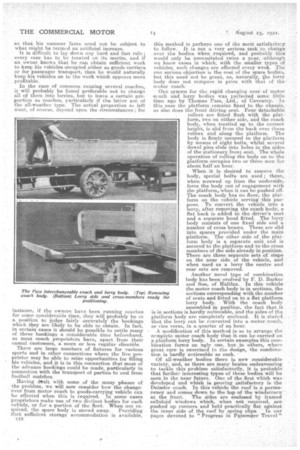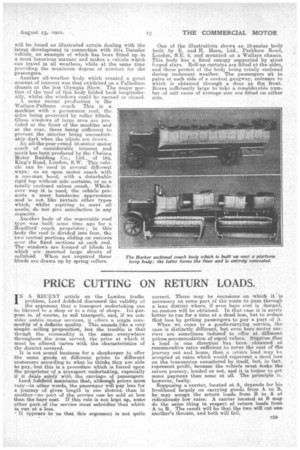ALL-THE-YEAR-ROUND FOR COACH CHASSIS.
Page 12

Page 13

Page 14

Page 15

If you've noticed an error in this article please click here to report it so we can fix it.
The Problem Which Has to be Fact Carrying. The Use of All-%4 Fleets
ing Motor Coach Chassis for Goods es, and Some Tyres. Mixed Work.
ONE OF the most difficult problems confronting those interested in the running of motor coaches is that of what is to be done with these vehicles during the ' winter-time, when inclement weather almost bars the use of any but the most adequately protected vehicles. It is very easy to speak of using the vehicles for the transport of goods, but there are many difficulties to be overcome before this can be carried into practice. For one thing, there is already considerable competition amongst hauliers in connection with the road transport of goods, and the influx of several thousand converted motor coaches would not tend to ease the situation.
On the other hand, even the most optimistic do not believe that motor coaches will ever be so popular during the winter as during the better seasons. The average Britisher does not look upon the winter as the time when he can make pleasure trips, and it is on the latter, that so much of the motor coach trade depends. In spite of this there are several fields of usefulness in which the all-weather motor coach could be exploited. A considerable, business is already done in catering for the requirements of the football enthusiasts, and, if the fares can be kept reasonably low, there is a great possibility that many people who have commenced to use the motor coach as a means of transport from place to place will prefer to continue this practice, even in bad weather, providing that reasonable comfort is ensured at. all times.
At present the number of all-weather motor coaches
in being is very lired, but there—are sufficient to enalale experiments in this direction to be carried out. For employing such vehicles various. other suggestions have been put forward. One is that they could be used as omnibuses running upon regular routes, but if this were done there would be a considerable amount of ill-feeling if, during the fine weather, the machines were taken off these routes to be run again as motor coaches, quite apart from the difficulty of arranging or temporary services with the licensing authorities.
In other quarters plans are being made' for the inauguration of regular parcels services between London and the provinces, with scales of charges which would be rather under the railway rates. Such services, although they present many possibilities, will require a considerable amount of organization, and it may be some time before they become pcpular amongst the general public. Here again the question of cessation of services during the summer months may cause them to lose the goodwill of the business. Dealing with the suitability of the raotOr coach chassis for the transport of goods, many of the chassis are little less than modified goods-carrying vehicles, but an increasing number' of. them are essentially chassis for passenger-carrying work, and are built only with this purpose in view. Such vehicles cannot well be modified .for goods transport, and thus on these it. would be an advantage to fit allweather bodies.
As regards the former class of vehicles, the 'modifications usually consist of lengthening the wheelbase and speeding up the vehicle.. by altering' the final drive gear ratio; in some caSes also., particularly with the larger vehicles, the frame is lengthened. These modifications, although they may not sound drastic, increase the difficulties of converting the machines for goods transport.. The long frame often results in the fitting of a. body with too great a load capacity, thus, perhaps unwittingly, making ,overleading a practice.
The difficulty regarding high-speed machines may be overcome by obtaining different gearing from the. makers, but this may entail the substitution of a different axle—a very expensive item.
" A fair number of vehicles is now shod either with . dual pneumatics on the rear Wheels and singles on the front or giant pneumatics all round. Unless these tyres are replaced by those of the solid variety, it will be a matter of considerable expense to ran these vehicles as lorries, and it may be economically impossible for them to compete with solid-tyred vehicles. Of course, this doesnot apply, to the lighter vehicles, but only to those which carry from, Say, 28 to 33 persons. There are naa.ny owners who prefer to lay up their vehicles during the winter months, and during • this time give them a complete overhaul, rather than t) use them all the year round, as, in the latter case, it usually means that another complete overhaul has to be given before they can again be made serviceable for the carriage of passengers, as, regrettable though it may be, a vehicle used for the transport of goods is often run 'until repairs are enforced, whereas where the safety of passengers is concerned, vehicles are usually kept in much better condition. Such a procedure has the "disadvantage that the fares 'charged whilst the vehicle is running must be high enough to compensate for the overhead charges which naturally continue whilst the machine is not employed. Thus, any competitor who is employing his vehicles as all-the-year-round vehicles, although perhaps net very profitably, will probably make enough during the winter more than to cover the overhead .charges and running costs,
so that his summer fares need not be subject to what relight be termed an artificial increase.
It is difficult to lay down any hard and fast rule ; every case has to he treated on its merits, and if an ownerknows. that he can obtain sufficient, work to keep his vehicles occupied either as goods carriers or for passenger transport, then he would naturally keep his vehicles on to the work which appears more profitable.
In the case of concerns running several coaches, it. will probably be found preferable not to change all of them into lorries, but to leave a certain proportion as coaches, particularly if the latter are of the all-weather type. The actual proportion go left must, of course, depend upon the eireurnstances ; for instance, if the owners have been running coaches for some consideralale time, they will probably be in a position to jedge fairly accurately the bookings which they are likely to be able to obtain.In fact, in certain cases it should be possible to settle many of these bookings a considerable time beforehand, as most. coach proprietors have, apart from their casual customers, a more or lees regular clientele. There are large numbers of fixtures for various sports and in other connections where the live proprietor may be able to seize opportunities for filling his vehicles, and it. is in this connection that most. of the advance bookinge could be made, particularly in connection with the transport of parties to and from football snatches, Having dealt with some of the many phases of the problem, we will now Consider how the change. over from motor coach to goods-carrying vehicle can be effected when this is required. In some cases proprietors make use of two die Linet bodies for each vehicle, or for a portion of the fleet. When not required, the spare body is stored away. Providing that sufficient storage accommodation is available, ol8 this method is perhaps one of the most satisfactory. to follow. It is not a very serious task, to change _ over the bodies when required, and probably this would only be necessitated twice a year, Although we know eases in which, with the smaller types of vehicles, such changes are effected every week. The one serious objection iE the coet of the spare bodies, but this need not be great, as, naturally, the lorry body does not compare in price with that of the motor coach.
One system for the rapid changing over of motor ceach and lorry bodies was perfected some little time ago by Thomas Pass, -Ltd., of Coventry, In this case the platform remains fixed to the chassis, as also does the front driving seat. Four detachable rollers are fitted flush with the platform, two on either side, and the coach body, when trestled up to the correct height, is slid from the back over these rollers and along the platform. The body is firmly secured to the platform by means of eight bolts, whilst several dowel pins slide into holes in the sides of the stationary front seat. The whole operation of rolling the body on to the platform occupies two or three men for about half an hour.
When .it is desired to remove the body, special bolts are used these, when screwed up from the underside, force the body out of engagement with the piatiorme when it can be pushed off. The coach body has no floor, the platform on the vehicle serving this purpose. _ To convert the vehicle into a lorry, after removing the coach body, a flat back is added to the driver's seat and a separate hood fitted. The lorry body consists of one fixed side and a number of cross beams. These are slid into spaces provided under the main platform. The other side of the platform body is a separate unit and is secured to the platform and to the cross members of the side already in position. There are three separate sets of steps on the near side of the vehicle, and when used as a lorry the centre and rear sets are removed.
Another novel type of combination body has boon evolved by F. D. Barker and Son, of Halifax. In this vehicle the motor coach body is in sections, the sections corresponding with the number of seats and fitted on to a fiat platform lorry body. With the coach body
assembled in position, the fact that it is in sections is hardly noticeable, and the sides of the platform body are completely enclosed. it is stated that the lorry can be converted into a motor coach, or vice versa, in a quarter of an hour.
A modification of this method is so to arrange the cernplete motor coach body that it can be earned on a platform lorry body. In certain examples this cornbieation forms an ugly one, but in others, where great care is exercised in the design, the oonibina.tier' is hardly noticeable as such.
Of all-weather bodies there is now considerable variety, and, as there are many brains endeavouring to tackle this problem satisfactorily, it is probable that further interesting types of these bodies will be seen in the near future. One of the first which was developed and which is proving satisfactory is the Daimler coach. In this vehicle the roof is a permanency and comes down to the top of the windscreen at the front. The sides are enclosed by framed celluloid windows which, when not required, are pushed up runners and held practically flat against
the inner side of the roof by spring clips, in our pages devoted to " Progress in Passenger Travel "
will be found an illustrated article dealing with the latest development in connection with this Daimler vehicle, an example of which has been fitted up in a most luxurious manner and makes a vehicle which can travel in all weathers, while at the same time providing the maximum degree of comfort for the passengers.
Another all-weather body which created -a great amount of interest was that exhibited on a Palladium chassis at the last Olympia Show. The major portion of the roofof this body folded back longitudinally, whilst the windows could be opened or closed. A more recent production is the Wallace-Pullman coach. This is a machine with a permanent roof,' the sides .being protected by roller blinds. Glass windows of large area are provided at the front of the machine and at the rear, these !being sufficient to prevent the interior being uncomfortably dark when the blinds are drawn.
An all-thelrear-round 16-seater motor coach of considerable interest and merit has been produced by the Chelsea Motor Building Co.; Ltd., . of 164, King's Road, London, S.W. This vehicle can be used in several different , ways: as an open motor coach with Ii one-man hood, with a detachable rigid top without side .curtains, or as a totally -enclosed saloon coach. Whichever way it is used, the vehicle presents a most handsome appearance and is not like pertain :other types which, whilst aspiring to meet all needs; do not give satisfaction in any capacity.
Another body of the removable roof type was built some time ago for a ,Bradford coach proprietor ; in this body the roof is divided into four, the two central portions sliding on runners over the fixed sections at each end. The windows are formedof blinds in which are inserted large sheets of celluloid. When not required these 'blinds are drawn up by spring rollers.
One of the illustrations shows an 18-seater body built by E. and H. flora, Ltd., Peckham Road, London, S.E. 5, and mounted on a Wallace chassis. This body has a fixed canopy supported by stout forged stays. Roll-up curtains are fitted at the sides, and these permit of the body being totally enclosed during inclement weather. The passengers sit in pairs at each side, of a central gangway; entrance to which is obtained through a door at the front. Boxes sufficiently large to take a considerable number of suit eases of averagesize are fitted on either side.
































